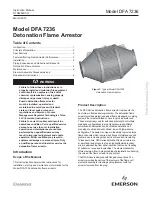
Maintenance
Detonation Flame Arrestor Element
Assembly Cleaning
1. Keep the element openings clean to prevent loss of
efficiency in absorbing heat. Remove the entire unit
and clean the elements to prevent the clogging of
particulates and other contaminants on the openings.
Clean the element with a suitable cleaning media
(solvent, soap, water or steam) then blow dry using
compressed air. Be careful not to damage or dent the
cell openings as this would hamper the effectiveness of
the unit. Do not clean the arrestor elements by rodding
with wire or other hard objects to remove blockages.
Cleaning the elements with wire or other hard objects
could damage the elements and seriously impair the
arrestor’s performance. If the arrestor element cannot
be cleaned satisfactorily, replace it.
2. For best cleaning results, use a high-pressure sprayer
with spray wand (1500 psig to 3000 psig / 103 to
207 bar) to clean the entire element surface. Hold the
spray nozzle perpendicular to the surface being cleaned
to maximize spray media penetration into the element.
Alternately spray each side of the element surface
until clean.
3. The cleaning interval should be governed by the
amount and type of particulate in the system to which
it is installed and must be determined by the user. To
determine the maintenance interval, the user should
check the element in the first few months of operation to
find how quickly particulate accumulates in the cells.
4. Thoroughly clean the gasket sealing faces being careful
not to damage the sealing surface. For reassembly, use
new gaskets and place them in the machined recess of
each interior flange on the two conical sections.
5. Replace the flame element assembly with a new
assembly or properly cleaned and inspected
existing unit.
6. Locate the flame cell assembly such that it seats onto
the gaskets.
7. Replace all tensioning studs and tighten the outer nuts
hand tight only.
8. Torque the bolts in sequence as shown in the Torquing
Instruction section.
Inspecting Model DFA Element Assembly
Following Flame Propagation Event
1. Inspect the outboard flame cells for damage
immediately following a deflagration, detonation and/or
stabilized burn.
2. Carefully remove the element assembly from the
arrestor with the entire flame arrestor out of the line.
3. Inspect the flame cells and the screens visually for
any signs of corrosion or other damage and inspect
the flame cells with a calibrated pin gauge to ensure
maximum crimp size openings do not exceed the
following values for their respective gas group. Use the
following pin gauges as no-go gauges:
• Model DFA-7326/D Explosion Group D (IIA) –
0.063 in. / 1.6 mm
4. If any damage is noted or crimp openings exceed
maximum size allowable as indicated by the entry of the
no-go gauge, replace the element assembly.
Note
Under no circumstance shall any element
assembly not provided by Emerson be used
in this assembly. Failure to use the correct
screens (internally between the flame cells)
may lead to arrestor failure.
Element Assembly, Disassembly and
Reassembly Instructions
WARNING
!
Isolate gas supply and bring system
to atmospheric pressure to prevent
ignitable gas from flashing while
performing maintenance.
CAUTION
Removal and installation of the detonation
arrestor and associated piping require the
use of adequate equipment and manpower
to prevent injury. The Model DFA-7236
detonation flame arrestor should be entirely
removed from the system for servicing.
To remove the element assembly:
1. Loosen all outermost nuts on tension studs.
2. Tighten the inside jacking nuts on the tension studs
forcing the two conical sections apart. When the two
flange faces have separated, remove the tension studs
that do not have inside jacking nuts, so that the element
assembly can be removed. The inside jacking nuts are
installed on all tension studs that facilitate jacking the
unit apart. The inside jacking nuts are not installed on
tension studs that are taken out, for ease of removal.
3. Thoroughly clean the gasket sealing faces being careful
not to damage the sealing surface. For reassembly,
lightly grease one side of a new gasket and place it in
the machined recess of each interior flange on the two
conical sections.
6
Model DFA 7236
North America
Only








